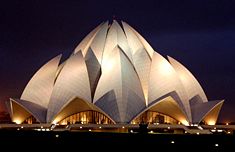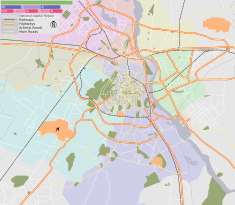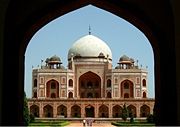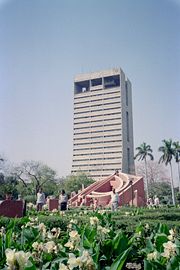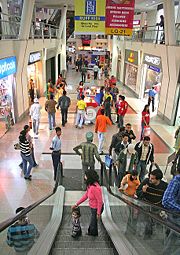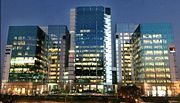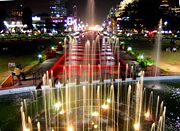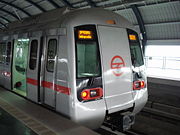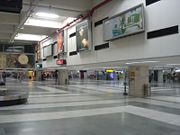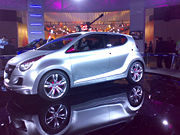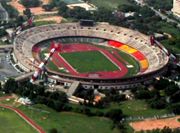Delhi
2008/9 Schools Wikipedia Selection. Related subjects: Asia; Asian Cities
| ?Delhi Delhi • India |
|
|
|
|
|
|
|
| Coordinates: | |
| Time zone | IST ( UTC+5:30) |
| Area • Elevation |
1,483 km² (573 sq mi) • 239 m (784 ft) |
| District(s) |
Districts of Delhi
|
| Population • Density • Metro |
13,782,976 (2,001 census) 17.076 million (2,008 estimate) ( 1st) ( 2007) • 11,463 /km² (29,689 /sq mi) • 25 million ( 2007) |
| Language(s) | Hindi, Punjabi, Urdu |
| Chief Minister | Sheila Dikshit |
| Lt. Governor | Tejendra Khanna |
| Mayor | Aarti Mehra |
| Established | 1 November 1958 |
| Legislature (seats) | Unicameral (70) |
| Codes • Pincode • Telephone • UN/LOCODE • Vehicle |
• 110 xxx • +9111 • INDEL • DL-xx |
| Website: delhigovt.nic.in | |
Coordinates:
Delhi (Hindi: दिल्ली; Punjabi: ਦਿੱਲੀ; Urdu: دلی; IPA: [d̪ɪlːiː]; sometimes referred to as Dilli) is the second largest metropolis in India, with a population of 17 million , and a federally-administered union territory officially known as the National Capital Territory of Delhi (NCT). Located on the banks of the Yamuna River in northern India, it is one of the oldest continually inhabited cities in the world.
Delhi has been the capital of several ancient Indian empires and a major city along the old trade routes between northwest India and the Indo-Gangetic Plains. It is the site of many ancient and medieval monuments, archaeological sites and remains. The Mughal emperor Shahjahan built the city, now known as "Old Delhi", to serve as the capital of the Mughal Empire from 1649 to 1857.
After the British Raj took control of India during the 19th century, Calcutta became the capital until George V announced in 1911 that it was to move back to Delhi. A new capital city, New Delhi, was built during the 1920s. When India gained independence from British rule in 1947, New Delhi was declared its capital and seat of government. As such, New Delhi houses important offices of the federal government, including the Parliament of India.
Owing to the immigration of people from across the country, Delhi has grown to be a cosmopolitan city. Its rapid development and urbanisation, coupled with the relatively high average income of its population, has transformed the city. Today, Delhi is a major cultural, political, and commercial centre of India.
Etymology
The etymology of "Delhi" is uncertain. The most common view is that it is an eponym of Dhillu, a king who ruled the area in ancient times. Some historians believe that the name is derived from Dilli, a corruption of dehleez or dehali— Hindustani for 'threshold'—and symbolic of city as a Gateway to the Indo-Gangetic Plain. Another theory suggests that the city's original name was Dhillika. The Hindi/ Prakrit word dhili ("loose") was also used for the area, and gradually transformed into the local name "Dilli". The coins in circulation in the region under the Tomara Rajputs were called dehliwal
History
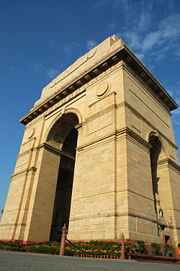
Human habitation was probably present in and around Delhi during the second millennium BC and before, as evidenced by archeological relics. The city is believed to be the site of Indraprastha, legendary capital of the Pandavas in the Indian epic Mahabharata. Settlements grew from the time of the Mauryan Empire (c. 300 BC). Remains of seven major cities have been discovered in Delhi. The Tomara dynasty founded the city of Lal Kot in 736 AD. The Chauhan Rajputs of Ajmer conquered Lal Kot in 1180 AD and renamed it Qila Rai Pithora. The Chauhan king Prithviraj III was defeated in 1192 by the Afghan Muhammad Ghori. In 1206, Qutb-ud-din Aybak, the first ruler of the Slave Dynasty established the Delhi Sultanate. Qutb-ud-din started the construction the Qutub Minar and Quwwat-al-Islam (might of Islam), the earliest extant mosque in India. After the fall of the Slave dynasty, a succession of Turkic and Central Asian dynasties, the Khilji dynasty, the Tughluq dynasty, the Sayyid dynasty and the Lodhi dynasty held power in the late medieval period, and built a sequence of forts and townships that are part of the seven cities of Delhi. In 1398, Timur Lenk invaded India on the pretext that the Muslim sultans of Delhi were too much tolerant to their Hindu subjects. Timur entered Delhi and the city was sacked, destroyed, and left in ruins. Delhi was a major centre of Sufism during the Sultanate period. In 1526, Zahiruddin Babur defeated the last Lodhi sultan in the First Battle of Panipat and founded the Mughal Empire that ruled from Delhi, Agra and Lahore.
The Mughal Empire ruled northern India for more than three centuries, with a five-year hiatus during Sher Shah Suri's reign in the mid-16th century. In the year 1556, a Hindu General Hemu Vikramaditya defeated Mughals and had his coronation at Purana Quila and re-established Vikramaditya dynasty. Mughal emperor Akbar shifted the capital from Agra to Delhi. Shah Jahan built the seventh city of Delhi that bears his name ( Shahjahanabad), and is more commonly known as the Old City or Old Delhi. The old city served as the capital of the Mughal Empire since 1638. Nader Shah defeated the Mughal army at the huge Battle of Karnal in February, 1739. After this victory, Nader captured and sacked Delhi, carrying away many treasures, including the Peacock Throne. In 1761, Delhi was raided by Ahmed Shah Abdali after the Third battle of Panipat. At the Battle of Delhi on 11 September 1803, General Lake's British forces defeated the Marathas.
Delhi came under direct British control after the Indian Rebellion of 1857. Shortly after the Rebellion, Calcutta was declared the capital of British India and Delhi was made a district province of the Punjab. In 1911, Delhi was again declared as the capital of British India. Parts of the old city were pulled down to create New Delhi; a monumental new quarter of the city designed by the British architect Edwin Lutyens to house the government buildings. New Delhi, also known as Lutyens' Delhi, was officially declared as the seat of the Government of India and the capital of the republic after independence on 15 August 1947. During the partition of India thousands of Hindu and Sikh refugees from West Punjab and Sindh migrated to Delhi. Migration to Delhi from the rest of India continues, contributing more to the rise of Delhi's population than the birth rate, which is declining.
The Constitution (Sixty-ninth Amendment) Act, 1991 declared the Union Territory of Delhi to be formally known as National Capital Territory of Delhi. The Act gave Delhi its own legislative assembly, though with limited powers.
Geography and climate
The National Capital Territory of Delhi is spread over an area of 1,483 km² (573 sq mi), of which 783 km² (302 sq mi) is designated rural, and 700 km² (270 sq mi) urban. Delhi has a maximum length of 51.9 km (32 mi) and the maximum width of 48.48 km (30 mi). There are three local bodies (statutory towns) namely, Municipal Corporation of Delhi (area is 1,397.3 km² (540 sq mi)), New Delhi Municipal Committee (42.7 km² (16 sq mi)) and Delhi Cantonment Board (43 km² (17 sq mi)).
Delhi is located at , and lies in northern India. It borders the Indian states of Uttar Pradesh on East and Haryana on West, North and South. Delhi lies almost entirely in the Gangetic plains. Two prominent features of the geography of Delhi are the Yamuna flood plain and the Delhi ridge. The low-lying Yamuna flood plains provide fertile alluvial soil suitable for agriculture. However, these plains are prone to recurrent floods. Reaching up to a height of 318 m (1043 ft), the ridge forms the most dominating feature in this region. It originates from the Aravalli Range in the south and encircles the west, northeast and northwest parts of the city. Yamuna, a sacred river in Hinduism, is the only major river flowing through Delhi. Most of the city, including New Delhi, lies west of the river. East of the river is the urban area of Shahdara. Delhi falls under seismic zone-IV, making it vulnerable to major earthquakes.
Delhi has a semi- arid climate with high variation between summer and winter temperatures. Summers are long, from early April to October, with the monsoon season in between. Winter starts in October and peaks in January and is notorious for its heavy fog. Extreme temperatures range from −0.6 °C (30.9 °F) to 47 °C (117 °F). The annual mean temperature is 25 °C (77 °F); monthly mean temperatures range from 14 °C to 33 °C (58 °F to 92 °F). The average annual rainfall is approximately 714 mm (28.1 inches), most of which is during the monsoons in July and August. The average date of the advent of monsoon winds in Delhi is 29 June..
Civic administration
As of July 2007, the National Capital Territory of Delhi comprises nine districts, 27 tehsils, 59 census towns, 165 villages and three statutory towns – the Municipal Corporation of Delhi (MCD); the New Delhi Municipal Committee (NDMC); and the Delhi Cantonment Board (DCB).
The Delhi metropolitan area lies within the National Capital Territory of Delhi (NCT). The NCT has three local municipal corporations: Municipal Corporation of Delhi (MCD), New Delhi Municipal Council (NDMC) and Delhi Cantonment Board. MCD is one of the largest municipal corporations in the world providing civic amenities to an estimated 13.78 million people. The capital of India, New Delhi, falls under the administration of NDMC. The chairperson of the NDMC is appointed by the Government of India in consultation with the Chief Minister of Delhi.
Delhi has four major satellite cities which lie outside the National Capital Territory of Delhi. These are Gurgaon and Faridabad (in Haryana), and NOIDA and Ghaziabad (in Uttar Pradesh). Delhi is divided into nine districts. Each district (division) is headed by a Deputy Commissioner and has three subdivisions. A Subdivision Magistrate heads each subdivision. All Deputy Commissioners report to the Divisional Commissioner. The District Administration of Delhi is the enforcing department for all kinds of State and Central Government policies and exercises supervisory powers over numerous other functionaries of the Government.
The Delhi High Court has jurisdiction over Delhi. Delhi also has lower courts; the Small Causes Court for civil cases, and the Sessions Court for criminal cases. The Delhi Police, headed by the Police Commissioner, is one of the largest metropolitan police forces in the world. Delhi is administratively divided into nine police-zones, which are further subdivided into 95 local police stations.
Government and politics

As a special union territory, the National Capital Territory of Delhi has its own Legislative Assembly, Lieutenant Governor, Council of Ministers and Chief Minister. The legislative assembly seats are filled by direct election from territorial constituencies in the NCT. However, the Union Government of India and the Government of National Capital Territory of Delhi jointly administer New Delhi. The legislative assembly was re-established in 1993 for the first time since 1956, with direct federal rule in the span. In addition, the Municipal Corporation of Delhi (MCD) handles civic administration for the city as part of the Panchayati Raj act. New Delhi, an urban area in Delhi, is the seat of both the State Government of Delhi and the Government of India. The Parliament of India, the Rashtrapati Bhavan (Presidential Palace) and the Supreme Court of India are located in New Delhi. There are 70 assembly constituencies and seven Lok Sabha (Indian parliament's lower house) constituencies in Delhi.
Delhi was a traditional stronghold of the Indian National Congress, also known as the Congress Party. In the 1990s the Bharatiya Janata Party (BJP) under the leadership of Madan Lal Khurana came into power. However in 1998, Congress regained power. Sheila Dixit of Congress is the incumbent Chief Minister. The Congress retained power in the Legislative Assembly in the 2003 election as well by a large margin. However, in 2007, the BJP scored a crushing victory over the ruling Congress in the MCD election, signalling a near certain return to power in the elections of Dec, 2008. Both parties have advocated full-fledged statehood for Delhi, but the process to establish this has been slow.
Utility services
The water supply in Delhi is managed by the Delhi Jal Board (DJB). As of 2006, it supplied 650 MGD (million gallons per day) of water, while the water demand for 2005–06 was estimated to be 963 MGD. The rest of the demand is met by private and public tube wells and hand pumps. At 240 MGD, the Bhakra storage is the largest water source for DJB, followed by river Yamuna and Ganges. With falling groundwater level and rising population density, Delhi faces severely acute water shortage. Delhi daily produces 8000 tonnes of solid wastes which is dumped at three landfill sites by MCD. The daily domestic waste water production is 470 MGD and industrial waste water is 70 MGD. A large portion of the sewerage flows untreated into the river Yamuna.
The city's per capita electricity consumption is about 1,265 kWh but actual demand is much more. In 1997, Delhi Vidyut Board (DVB) replaced Delhi Electric Supply Undertaking which was managed by the MCD. The DVB itself cannot generate adequate power to meet the city's demand and borrows power from India's Northern Region Grid. As a result, Delhi faces a power shortage resulting in frequent blackouts and brownouts, especially during the summer season when energy demand is at its peak. Several industrial units in Delhi rely on their own electrical generators to meet their electric demand and for back up during Delhi's frequent and disruptive power cuts. A few years ago, the power sector in Delhi was handed over to private companies. The distribution of electricity is carried out by companies run by Tata Power and Reliance Energy. The Delhi Fire Service runs 43 fire stations that attend about 15,000 fire and rescue calls per year.
State-owned Mahanagar Telephone Nigam Limited (MTNL) and private enterprises like Vodafone Essar, Airtel, Idea cellular, Reliance Infocomm and Tata Indicom provide telephone and cell phone service to the city. Cellular coverage is extensive, and both GSM and CDMA (from Reliance and Tata Indicom) services are available. Affordable broadband internet penetration is increasing in the city.
Economy
With an estimated net State Domestic Product (SDP) of INR 830.85 billion (FY 2005), Delhi is the second largest commercial centre in South Asia after Mumbai. Delhi has a per capita income of 53,976 INR which is around 2.5 times of the national average. The tertiary sector contributes 70.95% of Delhi's gross SDP followed by secondary and primary sectors with 25.2% and 3.85% contribution respectively. Delhi's workforce constitutes 32.82% of the population showing an increase of 52.52% between 1991 and 2001. Delhi's unemployment rate decreased from 12.57% in 1999–2000 to 4.63% in 2003. In December 2004, 636,000 people were registered with various employment exchange programmes in Delhi.
In 2001, the total workforce in all government (union and state) and quasi government sector was 620,000. In comparison, organised private sector employed 219,000. Delhi's service sector has expanded due in part to the large skilled English-speaking workforce that has attracted many multinational companies. Key service industries include information technology, telecommunications, hotels, banking, media and tourism. Delhi's manufacturing industry has also grown considerably as many consumer goods industries have established manufacturing units and headquarters in and around Delhi. Delhi's large consumer market, coupled with the easy availability of skilled labour, has attracted foreign investment in Delhi. In 2001, the manufacturing sector employed 1,440,000 workers while the number of industrial units was 129,000. Construction, power, telecommunications, health and community services, and real estate form integral parts of Delhi's economy. Delhi's retail industry is one of the fastest growing industries in India. However, as in the rest of India, the fast growth of retail is expected to affect the traditional unorganized retail trading system.
Transport
Public transport in Delhi is provided by buses, auto rickshaws, a rapid transit system, taxis and suburban railways.
Buses are the most popular means of transport catering to about 60% of the total demand. The state-owned Delhi Transport Corporation (DTC) is a major bus service provider for the city. The DTC operates the world's largest fleet of environment-friendly CNG buses. Though pollution from road transport has decreased in recent years, it is still at a high level.. A busway network, at present consisting of a single line between Ambedkar Nagar and Delhi Gate, is also under construction.
The Delhi Metro, a mass rapid transit system, serves many parts of Delhi. As of 2007, the metro operates three lines with a total length of 65 km (40 miles) and 59 stations while several other lines are under construction. Line 1 runs between Rithala and Shahdara. Line 2 runs in an underground tunnel between Vishwa Vidyalaya and the Central Secretariat. Line 3 runs between Indraprastha, Barakhamba Road, and Dwarka. The network is being expanded at a rapid pace with Phase-II under construction (128 km), expected to be completed by 2010. Phase III and IV will be completed by 2015 and 2020 respectively, creating a network spanning 413.8 km, longer than London's Underground
Railways served only 1% of the local traffic until 2003. However Delhi is a major junction in the rail map of India and is the headquarters of the Northern Railway. The four main railway stations are Old Delhi, Nizamuddin Railway Station, Sarai Rohilla and New Delhi Railway Station.
Auto rickshaws are an important and popular means of public transportation in Delhi, as they charge a lower fare than taxis. Most run on Compressed Natural Gas and are yellow and green in colour. Although they are equipped with electronic meters, which are supposed to show the fare, these are rarely used and bargaining is the norm.
Taxis are not an integral part of Delhi public transport, though they are easily available. Private operators operate most taxis, and most neighborhoods have a taxi stand from which taxis can be ordered or picked up. In addition, radio taxis, which can be ordered by calling a central number, have become increasingly popular. These are usually air-conditioned and charge a flat rate of Rs. 15 per kilometer.
Indira Gandhi International Airport (IGI) is situated in the southwestern corner of Delhi and serves for domestic and international connections. In 2006–07, the airport recorded a traffic of more than 20.44 million passengers, making it one of the busiest airports in South Asia. In future the airport will handle more than 100 million passengers per annum (more than what Atlanta airport, currently world's busiest airport, handles today). Safdarjung Airport is the other airfield in Delhi used for general aviation purpose. The proposed Taj International Airport is expected to be operational by 2012
Private vehicles account for 30% of the total demand for transport. At 1922.32 km of road length per 100 km², Delhi has one of the highest road densities in India. Delhi is well connected to other parts of India by five National Highways: NH 1, 2, 8, 10 and 24. Roads in Delhi are maintained by MCD (Municipal Corporation of Delhi), NDMC, Delhi Cantonment Board, Public Works Department (PWD) and Delhi Development Authority.
Delhi's high population growth rate, coupled with high economic growth rate has resulted in an ever increasing demand for transport creating excessive pressure on the city's existent transport infrastructure. As of 2008, Delhi had 55 lakhs (5.5 million) vehicles within its municipal limits, making most vehicle populous city of the world. Also, the number of vehicles in the metropolitan region, i.e., Delhi NCR ( National Capital Region (India)) is 112 lakhs (11.2 million), again surpassing all the metropolitan regions of the world like New York, Los Angeles, Tokyo, Seoul, Mexico City and others. In order to meet the transport demand in Delhi, the State and Union government started the construction of a mass rapid transit system, including the Delhi Metro. In 1998, the Supreme Court of India ordered all public transport vehicles to use compressed natural gas (CNG) as fuel instead of diesel and other hydro-carbons.
Demographics
| Population Growth of Delhi | |||
|---|---|---|---|
| Census | Pop. | %± | |
| 1901 | 405,819 |
|
|
| 1911 | 413,851 | 2.0% | |
| 1921 | 488,452 | 18.0% | |
| 1931 | 636,246 | 30.3% | |
| 1941 | 917,939 | 44.3% | |
| 1951 | 1,744,072 | 90.0% | |
| 1961 | 2,658,612 | 52.4% | |
| 1971 | 4,065,698 | 52.9% | |
| 1981 | 6,220,406 | 53.0% | |
| 1991 | 9,420,644 | 51.4% | |
| 2001 | 13,782,976 | 46.3% | |
| source: delhiplanning.nic.in † Huge population rise in 1951 due to large scale migration after Partition of India in 1947. |
|||
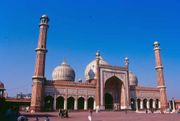
Many ethnic groups and cultures are represented in Delhi, making it a cosmopolitan city. A seat of political power and a centre of commerce, the city attracts workers—both blue collar and white collar—from all parts of India, further enhancing its diverse character. A diplomatic hub, represented by embassies of 160 countries, Delhi has a large expatriate population as well.
According to the 2001 Census of India, the population of Delhi that year was 13,782,976. The corresponding population density was 9,294 persons per km², with a sex ratio of 821 women per 1000 men, and a literacy rate of 81.82%. By 2003, the National Capital Territory of Delhi had a population of 14.1 million people, making it the largest metropolitan area in India surpassing Mumbai. This included 295,000 people living in New Delhi and another 125,000 in Delhi Cantonment. By 2004, the estimated population had increased to 15,279,000. That year, the birth rate, death rate and infant mortality rate (per 1000 population) were 20.03, 5.59 and 13.08, respectively.. Currently the city's municipal population is expected to be 17 million, making it the world's most populous city (but not the most populous metropolitan region, that being Tokyo) According a 1999–2000 estimate, the total number of people living below the poverty line in Delhi was 1,149,000 (which was 8.23% of the total population). In 2001, the population of Delhi increased by 285,000 as a result of migration and by an additional 215,000 as a result of natural population growth. The resulting high migration rate, made Delhi is one of the fastest growing cities in the world. By 2015, Delhi is expected to be the second largest agglomeration in the world after Tokyo.
Hinduism is the religion of 82% of Delhi's population. There are also large communities of Muslims (11.7%), Sikhs (4.0%), Jains (1.1%) and Christians (0.9%) in the city . Other minorities include Parsis, Anglo-Indians, Buddhists and Jews.
Hindi is the principal spoken and written language of the city. Other languages commonly spoken in the city are English, Punjabi and Urdu. Of these, English is an associate official language, and Punjabi and Urdu second official languages. Linguistic groups from all over India are well represented in the city; among them are Maithili, bhojpuri, Tamil, Kannada, Telugu, Bengali and Marathi. Punjabis, Jats and Gujjars are examples of the various ethnic communities in the city.
In 2005, Delhi accounted for the highest percentage (16.2%) of the crimes reported in the 35 cities in India with populations of one million or more. The city also has the highest rate of crime against women (27.6 compared to national average rate of 14.1 per 100,000) and against children (6.5 compared to national average of 1.4 per 100,000) in the country.
Culture
Delhi's culture has been influenced by its lengthy history and historic association as the capital of India. This is exemplified by the many monuments of significance found in the city; the Archaeological Survey of India recognises 175 monuments in Delhi as national heritage sites. The Old City is the site where the Mughals and the Turkic rulers constructed several architectural marvels like the Jama Masjid (India's largest mosque) and Red Fort. Three World Heritage Sites—the Red Fort, Qutab Minar and Humayun's Tomb—are located in Delhi. Other monuments include the India Gate, the Jantar Mantar (an 18th century astronomical observatory) and the Purana Qila (a 16th century fortress). The Laxminarayan Temple, Akshardham and the Bahá'í Lotus Temple are examples of modern architecture. Raj Ghat and associated memorials houses memorials of Mahatma Gandhi and other notable personalities. New Delhi houses several government buildings and official residences reminiscent of the British colonial architecture. Important structures include the Rashtrapati Bhavan, the Secretariat, Rajpath, the Parliament of India and Vijay Chowk. Safdarjung's Tomb is an example of the Mughal gardens style
Delhi's association and geographic proximity to the capital, New Delhi, has amplified the importance of national events and holidays. National events such as Republic Day, Independence Day and Gandhi Jayanti (Gandhi's birthday) are celebrated with great enthusiasm in Delhi. On India's Independence Day ( 15 August) the Prime Minister of India addresses the nation from the Red Fort. Most Delhiites celebrate the day by flying kites, which are considered a symbol of freedom. The Republic Day Parade is a large cultural and military parade showcasing India's cultural diversity and military might.
Religious festivals include Diwali (the festival of lights), Mahavir Jayanti, Guru Nanak's Birthday, Durga Puja, Holi, Lohri, Maha Shivaratri, Eid and Buddha Jayanti. The Qutub Festival is a cultural event during which performances of musicians and dancers from all over India are showcased at night, with the Qutub Minar as the chosen backdrop of the event. Other events such as Kite Flying Festival, International Mango Festival and Vasant Panchami (the Spring Festival) are held every year in Delhi. The Auto Expo, Asia's largest auto show, is held in New Delhi biennially.
Punjabi cuisine and Mughlai delicacies like kababs and biryanis are popular in several parts of Delhi. Due to Delhi's large cosmopolitan population, cuisines from every part of India, including Rajasthani, Maharashtrian, Bengali, Hyderabadi cuisines, and South Indian food items like idli, sambar and dosa are widely available. Local delicacies include Chaat and Dahi-Papri. There are several food outlets in Delhi serving international cuisine including Italian and Chinese.
Historically, Delhi has always remained an important trading centre in northern India. Old Delhi still contains legacies of its rich Mughal past that can be found among the old city's tangle of snaking lanes and teeming bazaars. The dingy markets of the Old City has an eclectic product range from oil-swamped mango, lime and eggplant pickles, candy-colored herbal potions to silver jewelry, bridal attire, uncut material and linen, spices, sweets. Some of old regal havelis (palacial residences) are still there in the Old City. Chandni Chowk, a three century old shopping area, is one of the most popular shopping areas in Delhi for jewellery and Zari saris. Notable among Delhi's arts and crafts are the Zardozi (an embroidery done with gold thread) and Meenakari (the art of enameling). Dilli Haat, Hauz Khas, Pragati Maidan offer a variety of Indian handicrafts and handlooms. However, the city is said to have lost its own identity and socio-cultural legacies as it went to absorb multitude of humanity from across the country and has morphed into an amorphous pool of cultural styles.
Education
Schools and higher educational institutions in Delhi are administered either by the Directorate of Education, the NCT government, or private organizations. In 2004–05, there were 2,515 primary, 635 middle, 504 secondary and 1,208 senior secondary schools in Delhi. That year, the higher education institutions in the city included 165 colleges, among them five medical colleges and eight engineering colleges, six universities— DU, JNU, JMI, GGSIPU, IGNOU and Jamia Hamdard—and nine deemed universities. GGSIPU is the only state university; IGNOU is for open/distance learning; the rest are all central universities.
Private schools in Delhi—which employ either English or Hindi as the language of instruction—are affiliated to one of two administering bodies: the Indian Certificate of Secondary Education (ICSE) and the Central Board for Secondary Education (CBSE). In 2004–05, approximately 15.29 lakh (1.529 million) students were enrolled in primary schools, 8.22 lakh (0.822 million) in middle schools and 6.69 lakh (0.669 million) in secondary schools across Delhi. Female students represented 49% of the total enrollment. The same year, the Delhi government spent between 1.58% and 1.95% of its gross state domestic product on education.
After completing the ten-year secondary phase of their education under the 10+2+3 plan, students typically spend the next two years either in junior colleges or in schools with senior secondary facilities, during which their studies become more focused. They select a stream of study— liberal arts, commerce, science, or, less commonly, vocational. Upon completion, those who choose to continue, either study for a 3-year undergraduate degree at a college, or a professional degree in law, engineering, or medicine. Notable higher education or research institutes in Delhi include All India Institute of Medical Sciences, Indian Institute of Technology Delhi, Netaji Subhas Institute of Technology, Delhi College of Engineering, Faculty of Management Studies, Delhi School of Economics, and Indian Institute of Foreign Trade.
Sports
As in the rest of India, cricket is a popular sport in Delhi. There are several cricket grounds (or maidans) located across the city, including the Feroz Shah Kotla stadium, one of the oldest cricket grounds in India to be granted status as venue for international cricket matches. The Delhi cricket team represents the city in the Ranji Trophy, a domestic first-class cricket championship played between different cities and states of India. The city is also home to the IPL team Delhi Daredevils. Other sports such as field hockey, football (soccer), tennis, golf, badminton, swimming, kart racing, weightlifting and table tennis are also popular in the city.
Sports facilities in Delhi include the Jawharlal Nehru Stadium and the Indira Gandhi Indoor Stadium. In the past, Delhi has hosted several domestic and international sporting events, such as the First and the Ninth Asian Games. The coming years will see the city host the 2010 Commonwealth Games, projected to be the largest multi-sport event ever held in the city. Delhi lost bidding for the 2014 Asian Games, but is bidding for 2020 Olympic Games. Delhi was chosen by the Fédération Internationale de l'Automobile to host the first ever Indian Grand Prix in 2010.
